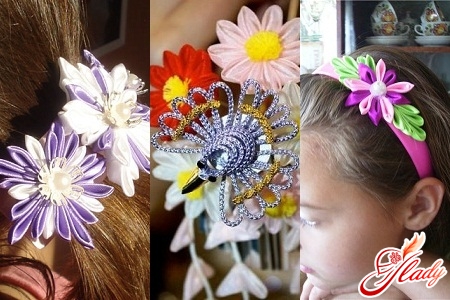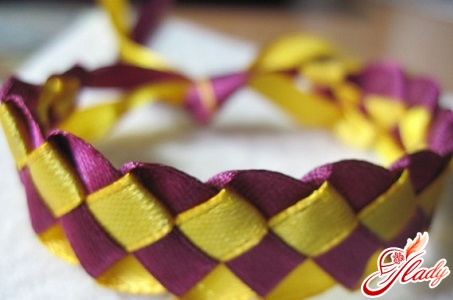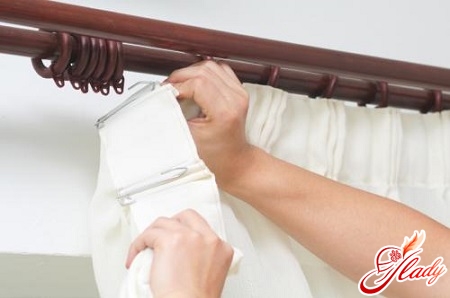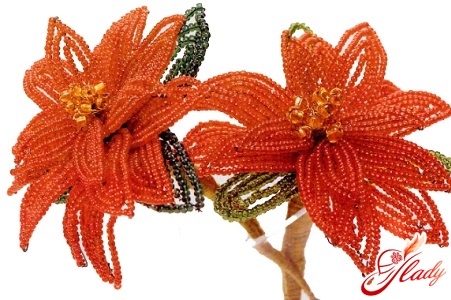 Origami, a traditional Japanese arttransforming the flat into the three-dimensional, was embodied in another technique of national handicraft of the Land of the Rising Sun - tsumami kanzashi. Its fruits, silk flowers, were originally intended to decorate all sorts of devices in geisha hairstyles: combs, sticks, hairpins. Fabric flowers became the main hair decoration in addition to silk kimonos, painted fans and fancy makeup. So, it is to geishas that we owe this unusual art of making exquisite jewelry, tsumami kanzashi.
Origami, a traditional Japanese arttransforming the flat into the three-dimensional, was embodied in another technique of national handicraft of the Land of the Rising Sun - tsumami kanzashi. Its fruits, silk flowers, were originally intended to decorate all sorts of devices in geisha hairstyles: combs, sticks, hairpins. Fabric flowers became the main hair decoration in addition to silk kimonos, painted fans and fancy makeup. So, it is to geishas that we owe this unusual art of making exquisite jewelry, tsumami kanzashi.
A bit of history and symbols
The art of tsumami-kanzashi is about four hundred years old.Around the 16th century, Japanese beauties developed a fashion for such complex hairstyles that they needed to be fixed somehow. For this, they used, first of all, hairpins. It was this hairdressing accessory that gave the name to the ancient art: "kanzashi" in Japanese means hairpin. Several types of hairpins were used in national women's hairstyles. These are hira-uchi (a hairpin with a round flat decoration), tama-kanzashi (decorated with a ball), a forked hairpin yoshicho and tsumami-kanzashi (hana-kanzashi) - a hairpin decorated with a silk flower. Such decorations retained their significance until the middle of the twentieth century. They were not just a fashionable decoration, but also had a symbolic meaning. For example, one could judge the social status of a Japanese woman by her hairstyle and the decorations in it. The hairstyle told about the social class of its owner, whether the Japanese woman was married or not, whether she had children and how many. Special seasonal decorations were made for each season. For spring - plum, peach and sakura flowers, for summer - hydrangea and carnation, for autumn - chrysanthemum and maple leaves, and in winter - decorations in the form of bamboo, pine, rice shoots. Certain events or occasions (for example, a wedding) also implied the presence of special hana kanzashi in women's hairstyles. In general, this decoration was and remains an indispensable attribute of the national Japanese women's costume. Even in modern Japan, women who wear a kimono are sure to wear classic kanzashi. And the outfit of a Japanese bride, even in the European version, will definitely have such an exquisite and luxurious decoration. Due to its uniqueness, the revived art of tsumami kanzashi is becoming very popular among fashionistas and needlewomen from different countries and continents. Its growing popularity is also explained by the amazing combination of simple technique and stunningly luxurious results.
Silk origami technique
 If traditional origami uses paper,then for tsumami kanzashi - fabric (in the classic version - natural silk). The technique is based on folding rectangular pieces of fabric in the form of oblong, round or pointed petals. It is from such petals that such exquisite and varied decorations are made, which surprise Japanese craftswomen. These can be small simple five-petal flowers, there can be more complex multi-tiered flowers from dozens of petals (like chrysanthemums), there can be whole cascading decorations from flower arrangements and pendants. The most amazing thing is that all this beauty is based on one single technique - folding (tsumami). This technique also requires the bare minimum of tools and materials. A novice craftswoman will only need:
If traditional origami uses paper,then for tsumami kanzashi - fabric (in the classic version - natural silk). The technique is based on folding rectangular pieces of fabric in the form of oblong, round or pointed petals. It is from such petals that such exquisite and varied decorations are made, which surprise Japanese craftswomen. These can be small simple five-petal flowers, there can be more complex multi-tiered flowers from dozens of petals (like chrysanthemums), there can be whole cascading decorations from flower arrangements and pendants. The most amazing thing is that all this beauty is based on one single technique - folding (tsumami). This technique also requires the bare minimum of tools and materials. A novice craftswoman will only need:
- fabric for petals and leaves;
- scissors for cutting workpieces;
- Lighter for singing edge of fabric and connecting parts;
- tweezers for convenient retention of small parts;
- Needle with thread for connecting petals;
- Adhesive for fastening jewelry on barrettes and stilettos.
It is worth noting that in classical techniqueKanzashi uses only natural silk and rice glue. Considering the high cost of these materials and the value of handicrafts, one can guess how much real Japanese Kanzashi cost. However, this technique is quite democratic. Modern jewelry is made from various types of fabric and using any synthetic glue. The main thing is to approach this activity creatively, and then an excellent result will not keep you waiting!
The principle of making silk flowers
 This Japanese handicraft is distinguished by its incredibleease of making products. To make silk flowers, you do not need any special tools - only manual dexterity and the imagination of the craftswoman. Here, for example, is a small kanzashi master class on making a flower with round petals. Fold a square piece of fabric in half (diagonally, fold up, corner down). Then fold the two extreme corners of the triangle to the bottom vertex to make a rhombus. Turn the rhombus face up (smooth side) and fold the right and left corners with the vertices to the center of the rhombus. Without turning over, fold in half (vertically) with the corners inward. Straighten the petal, holding the place where the corners are folded. Fasten the corners from the inside with glue or stitch and cut off the excess fabric. Gather six finished petals in the shape of a flower using a thread or glue them. Decorate the center of the flower with a bead (or several beads). Sharp petals are made even easier. Square - in half, as in the first case. Then in half again (from right to left). And in half again with sharp points facing each other. Fasten these points, cut off excess fabric. That's it - the petal is ready. Minimum effort, maximum pleasure from the result. See for yourself how easy it is to master this technique, especially if you use visual guides (there are plenty of them online). A little practice - and you will be able to make not only kanzashi with your own hands, but also brooches, hairpins, decorations for headbands, elements for wall panels - and you never know what your imagination will tell you! Use the elegant tsumami kanzashi technique to touch the secrets of the East and comprehend the harmony of silk origami. We recommend reading:
This Japanese handicraft is distinguished by its incredibleease of making products. To make silk flowers, you do not need any special tools - only manual dexterity and the imagination of the craftswoman. Here, for example, is a small kanzashi master class on making a flower with round petals. Fold a square piece of fabric in half (diagonally, fold up, corner down). Then fold the two extreme corners of the triangle to the bottom vertex to make a rhombus. Turn the rhombus face up (smooth side) and fold the right and left corners with the vertices to the center of the rhombus. Without turning over, fold in half (vertically) with the corners inward. Straighten the petal, holding the place where the corners are folded. Fasten the corners from the inside with glue or stitch and cut off the excess fabric. Gather six finished petals in the shape of a flower using a thread or glue them. Decorate the center of the flower with a bead (or several beads). Sharp petals are made even easier. Square - in half, as in the first case. Then in half again (from right to left). And in half again with sharp points facing each other. Fasten these points, cut off excess fabric. That's it - the petal is ready. Minimum effort, maximum pleasure from the result. See for yourself how easy it is to master this technique, especially if you use visual guides (there are plenty of them online). A little practice - and you will be able to make not only kanzashi with your own hands, but also brooches, hairpins, decorations for headbands, elements for wall panels - and you never know what your imagination will tell you! Use the elegant tsumami kanzashi technique to touch the secrets of the East and comprehend the harmony of silk origami. We recommend reading:









